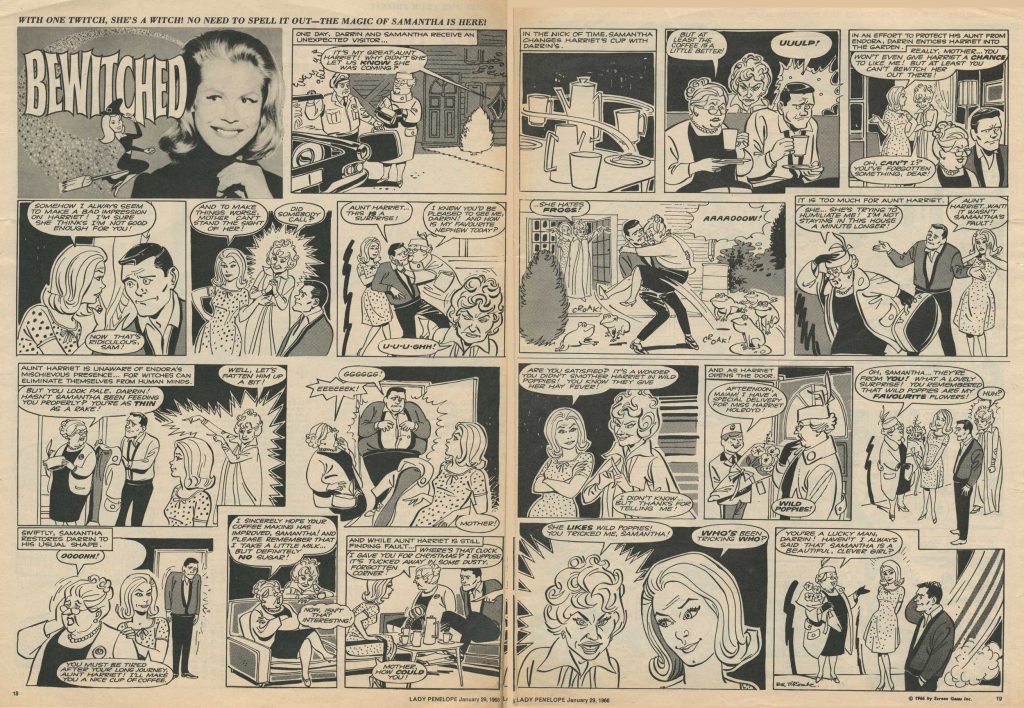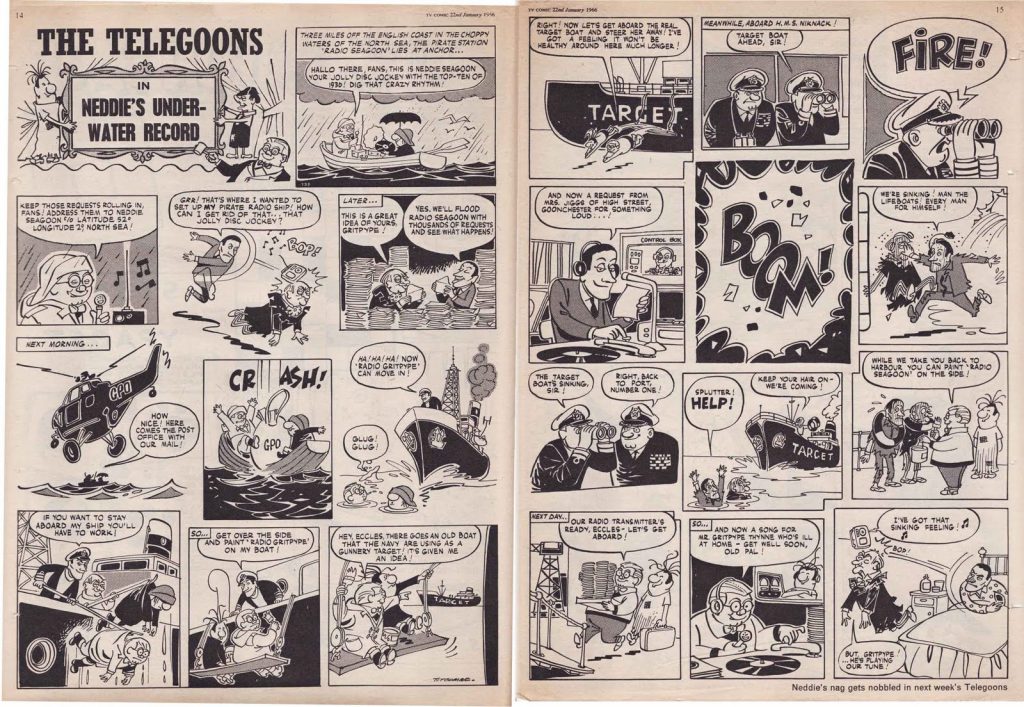
A very prolific and talented comic strip artist with many styles, perhaps best known for his work on Look-In and TV Comic, Bill Titcombe’s long career has spanned both illustrating children’s comics and books from the 1950s onwards, to paintings of his beloved birds and wildlife today.
Bill, full name William Thomas Roland Titcombe, was born in Romford, Essex in September 1938, son of Stewart Leslie Titcombe (14th April 1899-1952), a commercial artist, and his wife Edith née Littler, who married at Romford in 1927 and in 1939 Stewart was living at 11 Eccleston Crescent, Ilford, Essex.
Leaving school at the age 15 he when to work at publisher Amalgamated Press, where his career in British comics began in the late 1950s, initially working on Knockout, on strips such as “Billy Bunter”, and Film Fun, on “Jerry Lewis”, where his flair for caricature must surely have been quickly noted.
He went freelance in his early twenties, around the time he met wife to be Audrey Dorcas Taylor (1931 – 2010), who he married at Harrow, London in 1959, an author of a number of fondly-remembered children’s books. The couple first lived at Stanningfield, before moving to Beccles, both in Suffolk.

Bill’s most notable early work at Amalgamated Press was the creation of Buster, the son of Reg Smythe’s “Andy Capp”, for eponymous weekly comic Buster, later drawn by Hugh McNeill, a strip he drew from the title’s first issue until 1961, before moving on to work for other publishers.
“Bill was the first artist to visualise Buster 60 years ago,” notes fellow artist Lew Stringer. “Although the character was initially ‘The Son of Andy Capp’, Bill gave Buster his own personality, which I’m sure helped maintain the character’s success throughout the many changes of artists over the years.”
After working for Amalgamated, Bill’s uncanny ability for caricature resulted in employment adapting many favourite TV characters into comic strips for both City Editions and Polystyle Publications.

At City Editions, he drew almost every episode of “My Favourite Martian” for early issues of TV Century 21, which, despite several efforts, I have sadly never been able to persuade a publisher to republish as a print collection, working with rights holder Chertok TV. His credits for the title also included some episodes of “Get Smart”.
Over on TV Century 21‘s sister paper, Lady Penelope, Bill also provided the art for its “Bewitched” strip, skilfully capturing the likeness of series lead, Elizabeth Montgomery as the nose twitching suburban witch, and worked on the canine caper “What Did the Dog Say?”

He proved a stalwart of Polystyle Publications TV Comic, working on the weekly title from 1963 onwards, throughout the 1960s and beyond – sometimes having as many as four different strips on the go at once.
His credits on that long-running title included not only “TV Terrors”, a strip created specifically for the comic, beginning in 1963, but also, to name but a few, “Adam Adamant” (later drawn by Patrick Williams), “Animal Magic” starring Johnny Morris, “Barney Bear”, originated strips for the title starring “Beetle Bailey“, “Bootsie and Snudge”, “Bugs Bunny”, “Dad’s Army”, “The Dickie Henderson Family”, “Ken Dodd’s Diddymen“, starting in Issue 810, cover dated 24th June 1967, also providing illustrations for associated annuals), “The Telegoons”, some written by TV Century 21 editor and writer Alan Fennell, “Tom and Jerry”, starting in Issue 909, cover dated 17th May 1969, running for over 10 years into the 1980s; and “World Cup Willie”.

“The Telegoons” far exceeded the norm for a TV series tie-in, in that it outlived the television original by more than two years, starting in Issue 619, cover dated 26th October 1963, and running until Issue 787, cover dated 14th January 1967, running to some 169 weekly strips, as well as annual appearances.
“Dad’s Army“, Bill’s likenesses for this strip much praised by fans of the show that inspired it, also enjoyed a lengthy run, beginning in Issue 1058, cover dated 25th March 1972, its first run in the comic continuing until Issue 1100, cover dated 13th January 1973, then moving to TV Action. When that title merged with TV Comic with Issue 1133, cover dated 1st September 1973, “Dad’s Army” returned until issue 1275, cover dated 22nd May 1976.

“I first became aware of Bill’s work in the late 1960s when he was drawing the cover feature of TV Comic, ‘Ken Dodd’s Diddymen’,” notes Lew Stringer. “It caught my interest and I became a regular reader from that point. His style was so fresh and different from the usual material in children’s humour comics at the time.
“In 1969 ‘The Diddymen’ were replaced by ‘Tom and Jerry’ on the cover, also drawn by Bill,” Lew continues. “He captured the humour and fluidity of the characters perfectly. It must have been a huge hit with other readers too, as it remained on the covers for years.”

“I also admired Bill’s work on Look-In,” Lew says. “where he proved to be a superb caricaturist for the strips he drew based on TV personalities. Truly a master of his craft.”
On Look-In, the Junior TV Times, Bill’s credits included “Benny Hill“, “Doctor on the Go“, “Dogtanian” (also drawn by Neil Potter), Bruno Bianchi’s “Inspector Gadget”, “Mind Your Language“, “Scooby Doo”, Walter Lantz’ “Woody Woodpecker”, as well as many separate cartoon gags, something he would also contribute to IPC’s Krazy comic.


It should come as no surprise to learn that he worked on many annuals, too, drawing for the Mary, Mungo and Midge annuals in 1969 and 1970; and also drew a “Wind in the Willows” strip for Pippin between 1983 and 1986.
Alongside his comics strip work, Bill – who became an active member of the Society of Strip Illustrators in the 1970s – was also an artist for Dad’s Army books published by Piccolo in 1973, and his work also featured in Tom and Jerry comics for a Shreddies cereal promotion – and on lolly wrappers, too.



Bill did not confine his talents to the world of comics, however. Among other things, he also illustrated Tat the Cat, a series of books created by his wife, Audrey, and The Absent-minded Mallard, Morgan.

He continued to draw some strips for comics in the 1990s, including “Byker Grove” and “TV Centre” for Fast Forward, and “The Sunday Squad” for Roy of the Rovers Monthly.
But as the traditional British comics industry declined, he moved into new areas, including drawing the raunchy “Perils of Page 3 Pauline” strip for News of the World, written by Jonathan Stock.
The period proved something of a turning point in his life.
“I told Bill in 1991 that l admired his slick, fluid approach but really liked his mid-60s solid line/white outline style,” recalls Beano artist Nigel Parkinson, who also worked on Fast Forward.
“He said he’d been told by a friend that neither were very good and had he considered opening a pub. Which he then did!”
Fortunately, Bill didn’t completely abandon his art. From a studio in Beccles, Suffolk, he has been a prolific and highly regarded painter of wildlife, particularly birds, a passion he shared with his late brother Harry, who died in 2016.
In 2015, together with David Baxter, Miles Fairhurst and Stephen Govier, Bill opened The Art Gallery at the 18th century Earsham Hall, near to Bungay in 2015. On display there are some of Bill’s acrylics of birds and animals, along with the work of many new interesting and diverse artists.
Bill has also provided illustrations for film productions, including Prince Valiant in 1997, which was inspired by Hal Foster’s 1930s comic strip.

But clearly, Bill can’t quite put his comic strip skills behind him, because he also both wrote and drew Jungle Medics, a comic book project initiated back in 1997, published by Seafarer Books in 2015.
Crammed with gags at the expense of a much put upon cast of animal doctors – including a vegetarian lion and a myopic wild boar – Bill delivers a silly, Telegoons-tinged tale (tail?), occasionally breaking the fourth wall in its dialogue. Great fun for kids of all ages.
A stalwart of British comics for over 50 years, we hope this small tribute to a Master of British Comics offers some indication of how much his work is fondly remembered and has delighted many comic fans down the years – and, I hope, will long be celebrated.
• A checklist of Bill Titcombe’s work now features here as a separate article
FURTHER READING

• Bill Titcombe – Biography at Suffolk Artists
• The Art Gallery – Earnsham Hall
Some of Bill’s work is on display at this gallery near to Bungay, Suffolk
• Bill Titcombe Art on the Illustration Art Gallery
• Books featuring the work of Bill Titcombe on AmazonUK (Affiliate Link)
• Books featuring the work of Bill Titcombe on eBayUK
• Bill Titcombe – Telegoons Site
• Murdersville: Adam Adamant in TV Comic
• BFI – Bill Titcombe’s Film Credits
• Bill’s Tribute in The Guardian to his wife, Audrey
Bill described Audrey as an inspiration to all who knew her. “I met her in 1959 and was immediately taken by her generosity of spirit,” he recalled, “as she paid my bus fare to the station at Romford, north-east London, where we both lived. After a brief romance, we married and went on to live together for 51 years.”
• A checklist of Bill Titcombe’s work now features here as a separate article
With thanks for both images and memories to Matt Dyer, Peter Greenwood, Allan Harvey, Martin Hand, Nigel Parkinson, Tim Quinn, David A. Roach, Phil Shrimpton, Dez Skinn, Lew Stringer and Shaqui le Vesconte
All strips © respective licence holders and publishers, including Rebellion Publishing Ltd | All paintings and Jungle Medics © 2020 Bill Titcombe
The founder of downthetubes, which he established in 1998. John works as a comics and magazine editor, writer, and on promotional work for the Lakes International Comic Art Festival. He is currently editor of Star Trek Explorer, published by Titan – his third tour of duty on the title originally titled Star Trek Magazine.
Working in British comics publishing since the 1980s, his credits include editor of titles such as Doctor Who Magazine, Babylon 5 Magazine, and more. He also edited the comics anthology STRIP Magazine and edited several audio comics for ROK Comics. He has also edited several comic collections, including volumes of “Charley’s War” and “Dan Dare”.
He’s the writer of “Pilgrim: Secrets and Lies” for B7 Comics; “Crucible”, a creator-owned project with 2000AD artist Smuzz; and “Death Duty” and “Skow Dogs” with Dave Hailwood.
Categories: Comic Creator Spotlight, Creating Comics, downthetubes Comics News, downthetubes News, Features
 Remembering Jon Haward: A Tribute by Tim Perkins
Remembering Jon Haward: A Tribute by Tim Perkins  Catching up with the Comics Laureate! An interview with Bobby Joseph
Catching up with the Comics Laureate! An interview with Bobby Joseph  Comic Creator Spotlight: An Interview with Commando and Doctor Who writer Rossa McPhillips MBE
Comic Creator Spotlight: An Interview with Commando and Doctor Who writer Rossa McPhillips MBE  Creating Comics: Artist PJ Holden takes us behind the scenes on Garth Ennis’ new war comic, The Lion and the Eagle
Creating Comics: Artist PJ Holden takes us behind the scenes on Garth Ennis’ new war comic, The Lion and the Eagle
John, what a fascinating history! Thanks so much for sharing this! Is there any way of someone being able to acknowledge your country’s artists in something akin to a “Hall of Fame”? Surely Bill Titcombe deserves to rank among the masters of the craft and should never be forgotten. Brilliant piece! I enjoyed the read immensely.
Thanks very much – there really should be some kind of British Comic Awards again, shouldn’t there. Tripwire has its awards of course, and ComicScene, too, but nothing akin, perhaps to the old Eagle Awards, which, it’s my understanding are snarled up in legal issues.